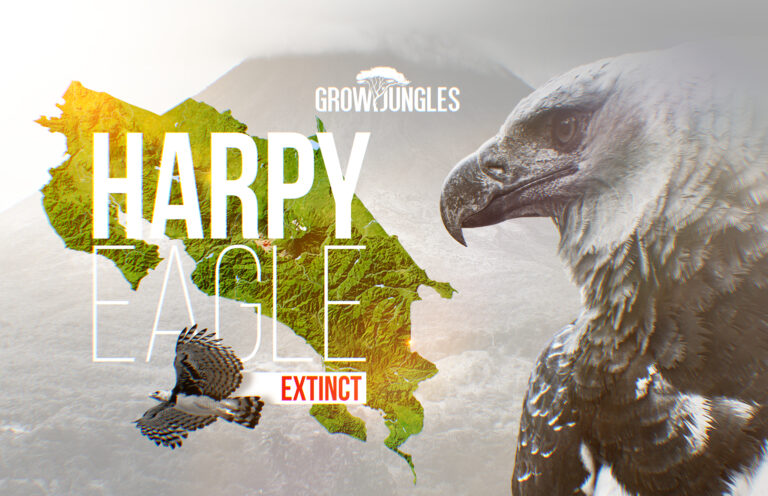Home » Extinction » The Extinction of the Harpy Eagle (Harpia harpyia) in Costa Rica

As stated in early Greek mythology, the conquistadors settlers saw the harpy as a “frightful, flying creature with hooked beak and claws.” For many tribes deep in the rainforest, the harpy is believed to be an embodiment of tribal chiefs, a symbol of willingness and bravery.
Habitat: Harpy Eagles inhabit an extensive range of areas, including Brazil, Belize, Costa Rica, Ecuador, Mexico, Venezuela, and Paraguay; however, they are generally sparsely distributed (1). As a Neotropical Rainforest species, they live at low elevations to find prey in the highly biodiverse rainforests and nest in large trees.
Historically, Harpy Eagles were found from southern Mexico through Central and South America and northern Argentina (2). Sadly, they are now thought to be locally and regionally extinct in larger Central and North Central America (1). In Panama, there is the largest known breeding population, whereas in El Salvador, they are virtually extinct. And only one nesting pair has been found in Belize (2).
Diet: To be considered one of the most powerful eagles in the world, the Harpy Eagles’ thick tarsi (legs), strong toes, and sharp talons make this species an impressive predator. They feed on medium-sized mammals with a varied diet, such as iguanas, parrots, toucans, raccoons and porcupines. They have even been seen to prey on foxes ( 2). Impressively, Harpy Eagles can go an extensive amount of time without eating. They have been known to wait as long as a week, and if they can hunt a decent size prey, they will continue to feed on this animal for several days (1).
Life History: Harpy Eagles are known to reach adulthood when they are about five years old. Their white and light grey feathers molt yearly and be replaced with darker feathers (eventually black and dark grey but white on the belly) as each year they get closer to adulthood. This coloration is used to help them identify a mature mate. It is said to believe that Harpy Eagles stay with the same companion for life for around 25-30 years ( 2).
Harpy Eagles tend to nest in areas with little human disturbance where it is fairly pristine (3), typically in the taller trees. It is there where the mother will lay 1-2 eggs and incubate them for approximately 55 days. In most cases, only one of the two eggs will survive. As very protective parents, the Harpy Eagle mothers will spend most of their time in the nest as the father takes care of them by looking for food. The young birds will remain dependent on the parents for the first one to two years of life and then be ready to fly solo and find a home of their own. Generally, every two years, a pair of Harpy Eagles will raise their young (2).
As deforestation escalates along with the threats the Harpy Eagles face due to hunting, low overall population densities and slow reproductive rates make them highly vulnerable and, therefore, a nearly threatened species (1). Along with this, Harpy Eagles are less likely to nest in areas with a large amount of human disturbance; therefore, with the ever-growing expansion of deforestation, nesting areas are continuing to sink in size. As a top predator in the rainforest, the Harpy Eagle plays an enormous role in stabilizing prey populations. In doing so, they are playing a vital role in preventing overpopulation, reducing disease and starvation (4). Despite there being legal protection in several countries (Brazil, Panama, and Suriname), it has been proven that these laws are difficult to enforce as the areas are so remote (1). One of the last documented sightings of Harpy Eagle was in Corcovado, believed to have flown over from Panama and created a nesting area in Corcovado. The recorded sighting in Corcovado National Park witnessed a healthy chick close to the fledging nest. One day, it was reported the chick disappeared, and rumors spread that a poacher climbed the tree and stole the young bird to sell for a great deal of money. This type of poaching has been suggested to be one of the greatest threats that the Harpy Eagle faces (5).
Predators depend on space and animals for food. The Harpy Eagle needs our help due to the misunderstanding about the bird’s behavior, which makes people fear and kill them. During 2002, the Peregrine Fund survey revealed people were afraid that they would attack their families (2).
In 1989, the Peregrine Fund began breeding Harpy Eagles in captivity and then returning the species to some of its natural rainforest habitat (2). This was the start of a special breeding program. In 2001, they started the construction of the Neotropical Raptor Center and breeding facility in Panama City. In just one year, 17 eagles hatched, and almost 50 have been released since 1998. For more than ten years, biologists have been observing the wild populations of the Harpy Eagle in Panama and are gaining more and more extensive knowledge as to the species’ habitats, needs, nesting behavior, and diet and therefore, will help the Peregrine Fund better understand how to protect these incredible eagles and increase their numbers.
Additionally, this program carried out an education campaign designed to inform people that the eagles aren’t as dangerous as they seem and aim to educate people on why they should be protected. This is done through a series of talks conducted at schools, in communities, radio, messages, and hosted festivals. By changing people’s attitudes towards these beautiful creatures, Panama’s country declared the Harpy Eagle as its national bird on April 10, 2002 (2).

Founder of Grow Jungles